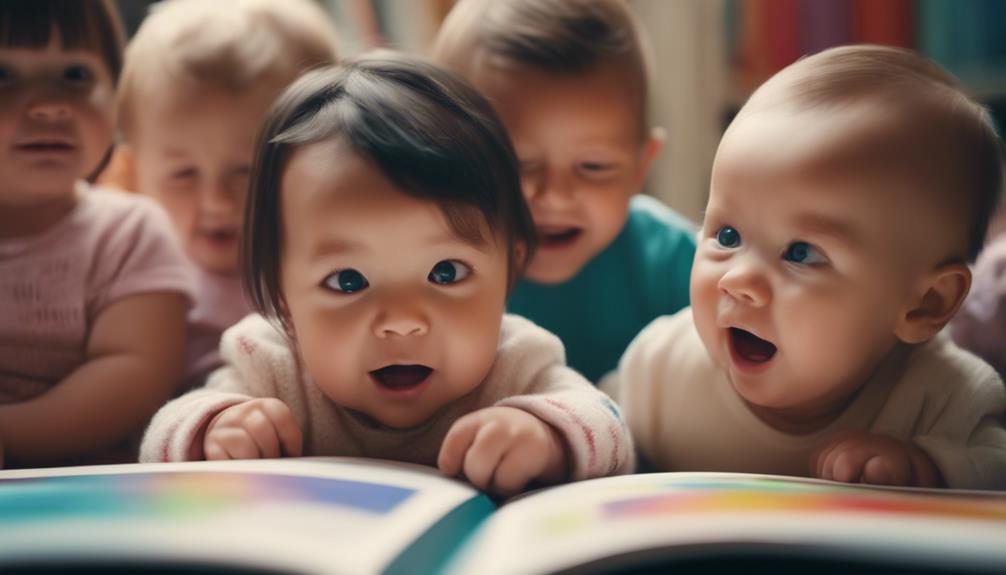Picking **books on baby emotions** helps little ones grasp feelings. Look for titles like **’Baby Faces’** and **’The Feelings Book’** which dive right into emotions. **’Babys Feelings’** and **’Making Faces’** help kids get a handle on feelings early. Try **interactive books** like **’Baby Einstein – My First Feelings Mirror Book’** which has touchy-feely parts. For positive thoughts, check out **’I Am: Positive Affirmations for Kids.’** Remember to consider how suitable the book is for your kid’s age and its engagement level. Each book carries unique benefits, gently building emotional understanding.
Key Takeaways
- Look for books with interactive features like flaps, mirrors, and touch-and-feel elements.
- Choose books that cover a wide emotional range from happiness to sadness.
- Opt for age-appropriate content that resonates with your child's developmental stage.
- Prioritize engaging visuals with colorful illustrations and diverse characters.
- Consider books with positive affirmations and strategies for emotional regulation.
Babys Feelings – A First Book of Emotions – Educational

For parents seeking an engaging and educational tool to help their young children understand and express emotions, Babys Feelings – A First Book of Emotions is the perfect choice. This board book, featuring a soft padded cover, captures the attention of children aged 1 to 5 years old with its sweet photos of real babies displaying various emotions.
The book's durability and engaging content have garnered positive feedback from parents and caregivers, who appreciate its ability to help children communicate and comprehend feelings like happy, angry, sad, and surprised.
Through interactive learning, children are encouraged to mimic the facial expressions depicted, fostering emotional awareness and expression. With 24 pages and dimensions of 7 inches x 7 inches, this book isn't only educational but also a valuable tool for children's emotional development.
Best For: Parents looking for an interactive and durable educational tool to help their young children understand and express basic emotions effectively.
Pros:
- Diverse range of emotions depicted by real babies.
- Engaging content that encourages children to mimic facial expressions.
- Helps children communicate and comprehend feelings like happy, angry, sad, and surprised.
Cons:
- Limited to basic emotions, may not cover more complex feelings.
- Targeted age group may not engage older children.
- Some children may not find the book visually appealing.
Making Faces: A First Book of Emotions (Baby Loves Books)
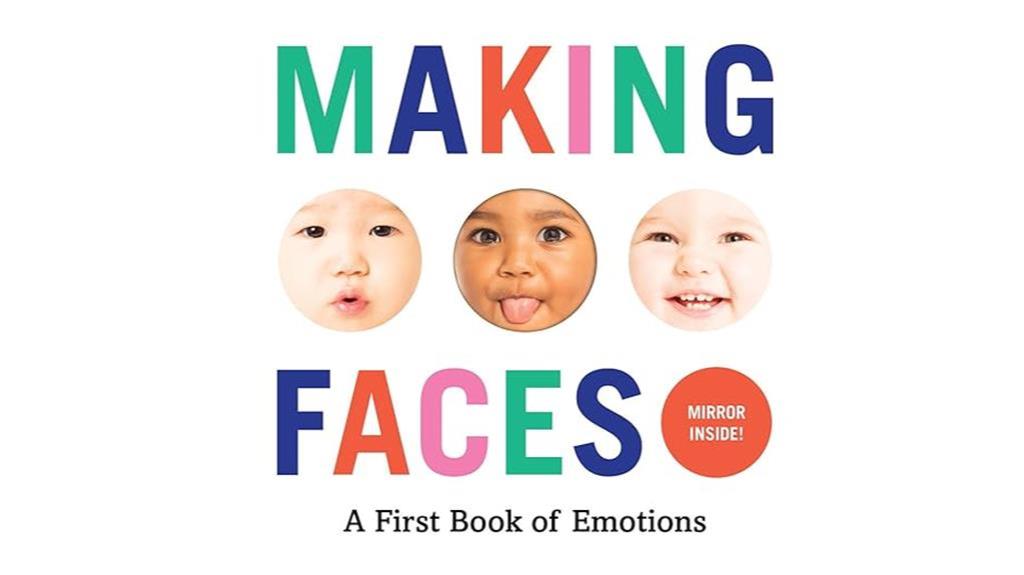
Interested in a book that uses real baby faces to teach emotions interactively? 'Making Faces: A First Book of Emotions (Baby Loves Books)' is a highly recommended choice for engaging your little one in learning about feelings.
This interactive photographic board book introduces essential expressions like happy, sad, angry, surprised, and silly through real baby faces instead of cartoons. It encourages children to mimic and identify these emotions, fostering important developmental skills.
The mirror feature included in the book allows children to see their own facial expressions and encourages them to mimic different emotions, making the learning experience more immersive and enjoyable.
With positive reviews praising its educational value and interactive nature, this book is a valuable tool for helping children understand and express their feelings effectively.
Best For: Parents looking for an interactive and educational book to teach children about emotions through real baby faces.
Pros:
- Encourages children to mimic and identify essential expressions
- Includes a mirror feature for children to see and mimic their own facial expressions
- Highly recommended for children with special needs or autism
Cons:
- Limited language options available for multilingual households
- May not appeal to children who prefer cartoon illustrations
- Mirror feature could potentially break if mishandled
Baby Faces
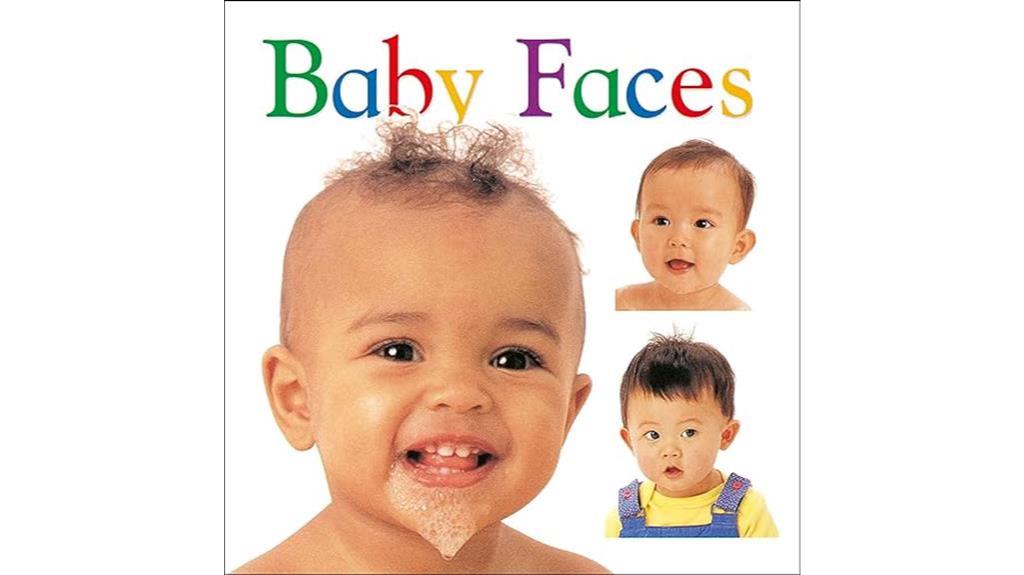
The enchanting photos of baby faces displaying various emotions in the book 'Baby Faces' are ideal for introducing young children to recognizing and understanding different feelings.
This sturdy board book features bright and colorful images of babies showing emotions like happiness, sadness, sleepiness, and more. The simple word labels accompanying each photo help babies and toddlers associate the expressions with the corresponding feelings.
The durable pages make it a long-lasting addition to a child's library, perfect for repeated readings and exploration. 'Baby Faces' is designed to engage young minds in early childhood development by familiarizing them with common facial expressions and aiding in their emotional understanding.
This book offers a valuable tool for parents and caregivers to support children in learning about and expressing their emotions effectively.
Best For: Parents looking to introduce their babies and toddlers to recognizing and understanding different emotions through engaging and colorful visuals.
Pros:
- Engaging photos of baby faces displaying various emotions.
- Simple word labels accompanying each photo for easy association.
- Sturdy board book with durable pages, making it long-lasting for young children.
Cons:
- Limited focus on a range of complex emotions.
- May not have extensive interactive features for further engagement.
- Some parents may prefer a more interactive learning approach.
Baby Einstein – My First Feelings Mirror Book – PI Kids
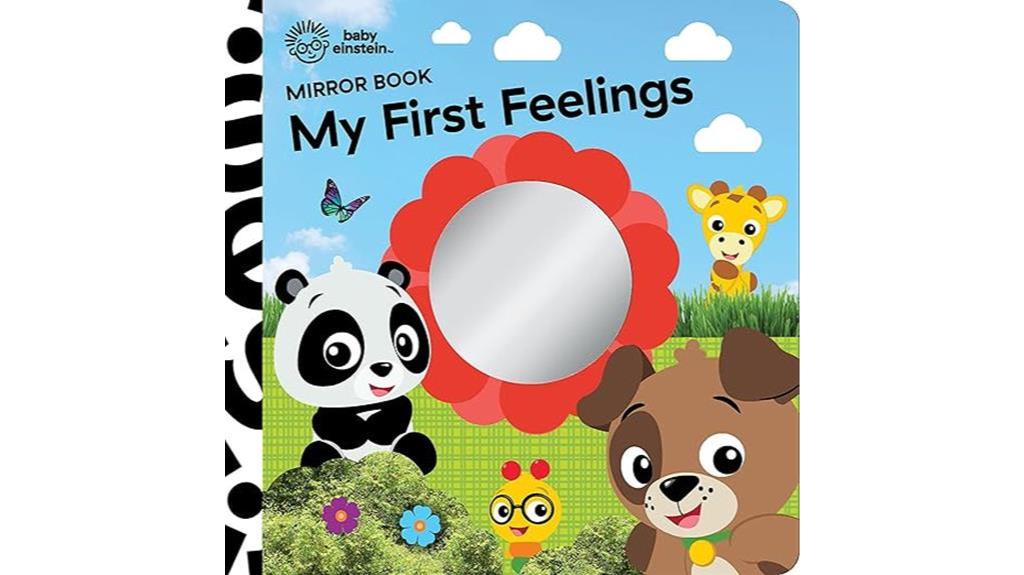
With its engaging mirrors and interactive prompts, the Baby Einstein – My First Feelings Mirror Book – PI Kids is a perfect choice for babies who enjoy exploring their own expressions and emotions. This book features five shaped mirrors that allow curious eyes to discover faces and emotions, creating an interactive and fun learning experience.
As caregivers read the book, little ones are prompted to make faces into the mirrors, encouraging a playful interaction that helps children understand feelings in an engaging way. Customer reviews highlight the enjoyment babies experience while looking at themselves in the mirrors, with comments emphasizing how the book grows with the child.
The colorful illustrations and adorable Baby Einstein animals further enhance the overall appeal of this mirror book, making it a valuable addition to a baby's library.
Best For: Parents looking for a interactive book that helps babies explore their own expressions and emotions through mirrors. This engaging book not only captivates young minds but also encourages self-recognition and emotional awareness from an early age. With colorful illustrations and sturdy mirror pages, it makes learning both fun and interactive. It’s often regarded as one of the best baby learning books for fostering social-emotional development in infants.
Pros:
- Interactive mirrors engage babies in discovering faces and emotions.
- Encourages playful interaction between child and caregiver.
- Helps children understand feelings in an engaging way.
Cons:
- May require supervision to ensure safe use of mirrors.
- Limited content beyond the interactive mirror feature.
- Some babies may lose interest if not attracted to their own reflection.
The Feelings Book
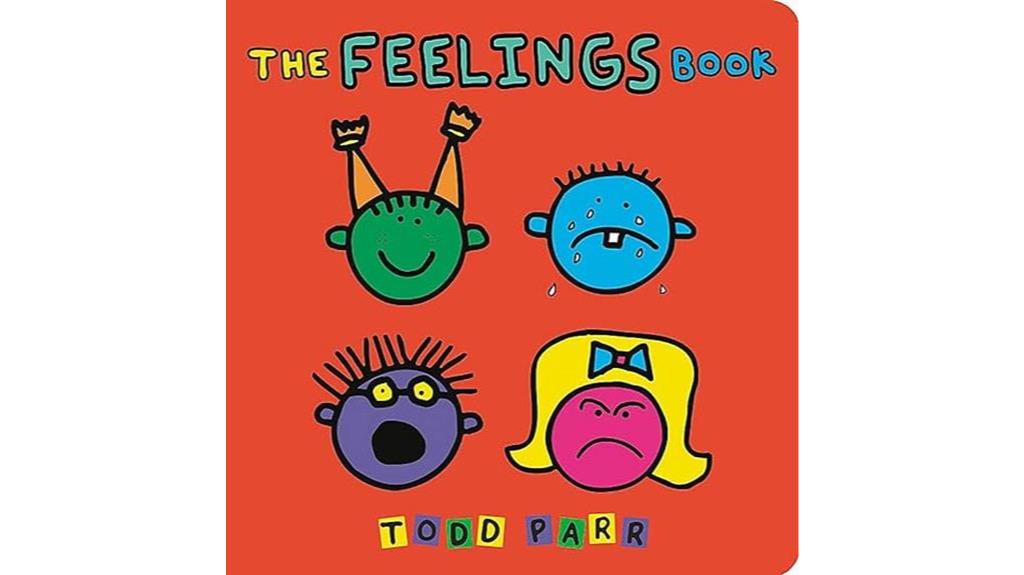
For parents seeking a vibrant and engaging book to help their young children understand and accept a wide range of emotions, 'The Feelings Book' by Todd Parr is an excellent choice. This colorful and fun book is designed to assist kids in comprehending and embracing their feelings through bold, simple, and silly illustrations that resonate with young readers.
Todd Parr's ability to convey subtle yet effective messages about emotions has garnered praise for 'The Feelings Book'. Known for its vibrant childlike illustrations, this book discusses various emotions in a concrete and relatable manner, making it a valuable tool for initiating conversations about feelings with children.
Readers appreciate the pedagogical value of Todd Parr's work, finding his books, including 'The Feelings Book', instrumental in helping children navigate and understand their emotions in a positive and engaging way.
Best For: Parents looking for a colorful and engaging tool to help young children understand and accept their emotions effectively.
Pros:
- Vibrant and engaging illustrations that appeal to young readers.
- Subtle yet impactful messages about emotions.
- Effective in initiating conversations about feelings with children.
Cons:
- May be too simplistic for older children or advanced readers.
- Limited depth in emotional exploration compared to more in-depth resources.
- Some parents may prefer a more comprehensive guide to emotions for children.
My First Book of Emotions for Toddlers
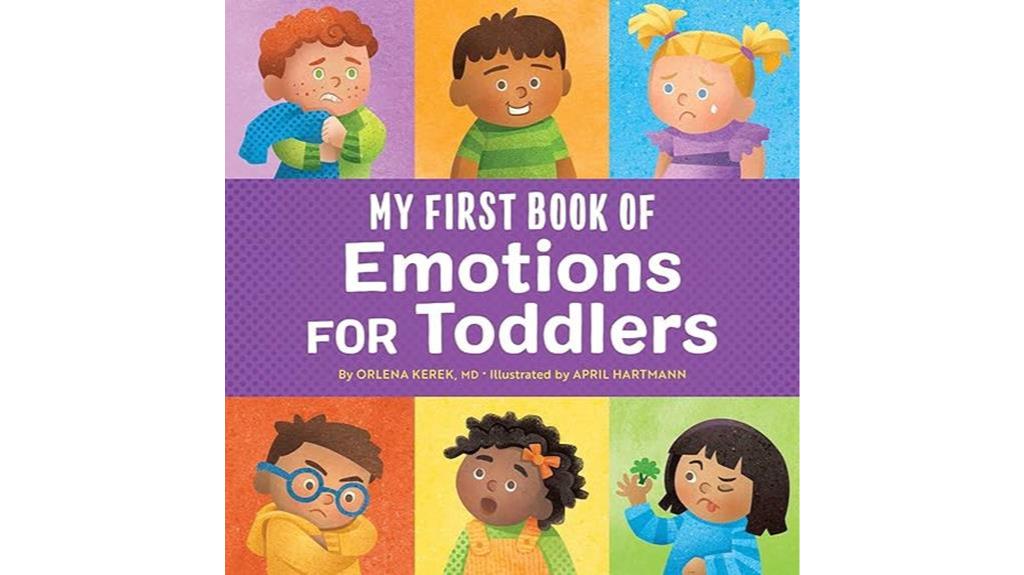
Best choice for toddlers exploring emotions: 'My First Book of Emotions.' This engaging book introduces young children to a range of common feelings, aiding them in understanding and managing their emotions.
With colorful illustrations and simple language, it covers essential emotions like fear, anger, joy, sadness, disgust, and surprise.
Parents appreciate how this book helps regulate emotions and encourages discussions about feelings, fostering emotional intelligence in children aged 3 and up.
Grandparents have observed their grandchildren preferring this book over others, citing its ability to stop emotional outbursts and expand vocabulary.
The artwork is vibrant and diverse, depicting various emotions, making it an excellent tool for promoting interaction, speech development, and communication skills in toddlers.
Best For: Parents seeking a colorful and engaging tool to help toddlers understand and manage a range of emotions effectively.
Pros:
- Introduces toddlers to essential emotions in a simple and engaging manner
- Encourages emotional regulation and vocabulary expansion
- Promotes discussions about feelings and nurtures emotional intelligence from a young age
Cons:
- Might not be suitable for children under 3 years old due to complexity of emotions covered
- Some parents may prefer more text or detailed explanations in the book
- Artwork suggestions for better visibility may not align with personal preferences
I Am: Positive Affirmations for Kids
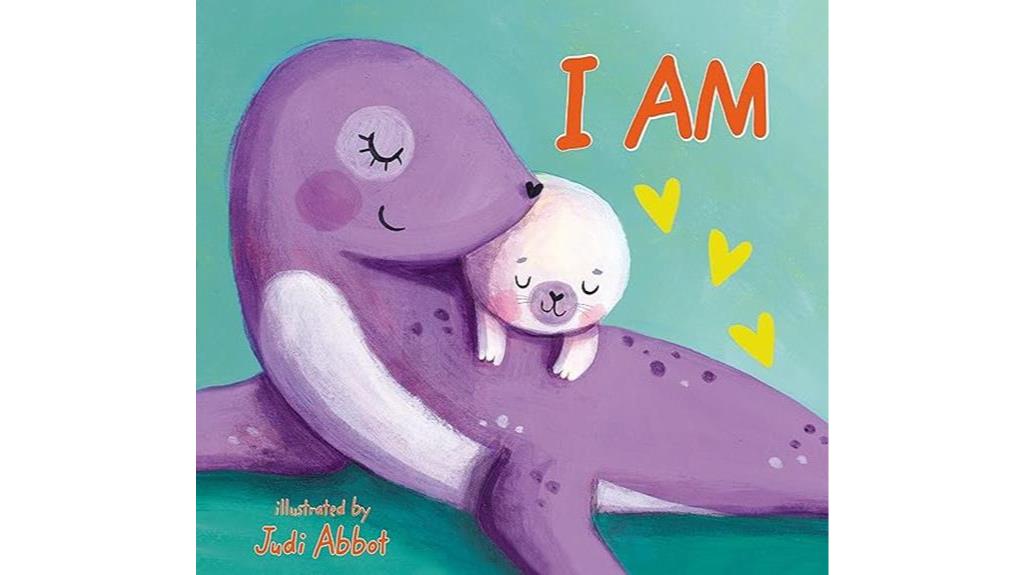
'I Am: Positive Affirmations for Kids' is a valuable resource for parents looking to instill confidence and positivity in their young children through empowering affirmations. This book has garnered positive reviews, with parents noting how their children love reciting the affirmations and how it helps in building their confidence.
The impact on children is evident, with little ones repeating affirmations and visibly perking up during tough moments. The book features simple wording, easy-to-read text, and charming illustrations that appeal to children.
By emphasizing affirmations like 'I am strong, I'm kind, and I'm smart,' 'I Am' empowers children and reinforces positive self-perception. Parents appreciate the book's ability to instill positive thoughts and self-acceptance in their young ones, making it a beloved addition to their children's book collection.
Best For: Parents looking to instill confidence and positivity in their young children through empowering affirmations.
Pros:
- Empowers children with affirmations like 'I am strong, I am kind, and I am smart'.
- Features simple wording and charming illustrations that appeal to children.
- Helps toddlers ages 0 to 4 build confidence and create a foundation of positivity and self-acceptance.
Cons:
- May be too simplistic for older children.
- Limited content for extended use over time.
- Some children may lose interest in repetitive affirmations.
Little Monkey Calms Down (Hello Genius)
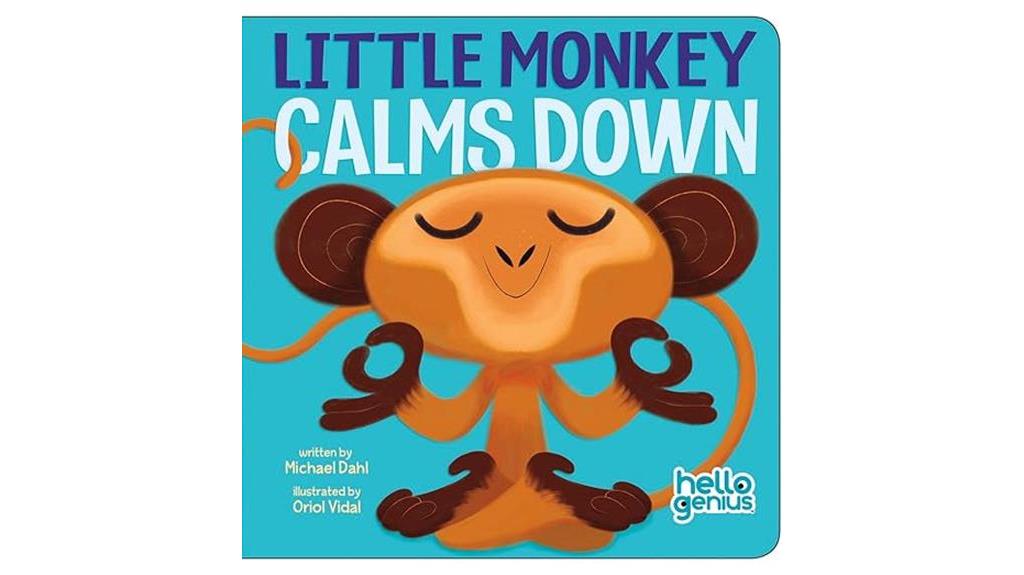
Parents and educators have noted that 'Little Monkey Calms Down' from the 'Baby Emotions Books' series is particularly beneficial for children with special needs, such as language delays or processing issues. This book's simple word structure and expressive illustrations make it easier for children with autism to relate to, aiding in emotional understanding and regulation.
While the book provides suggestions for self-calming, parents may need to customize these strategies to suit their child's specific needs. The overall message that calming down is a skill within the child's control has been well received by both parents and professionals.
'Little Monkey Calms Down' has proven effective in helping children manage and soothe negative emotions, fostering improvements in emotional intelligence and self-soothing efforts.
Best For: Children with special needs, such as language delays or processing issues, who benefit from simplified language and expressive visuals for emotional understanding.
Pros:
- Effective in helping children manage and soothe negative emotions.
- Simple word structure and colorful illustrations aid in emotional regulation.
- Parents and caregivers appreciate the book's message of self-calming and emotional control.
Cons:
- Some strategies for self-calming may require additional customization for individual children.
- Limited focus on specific special needs beyond language delays and processing issues.
- May not appeal to children who prefer more complex storylines or illustrations.
Baby Faces Peekaboo!: With Mirror, Touch-and-Feel, and Flaps
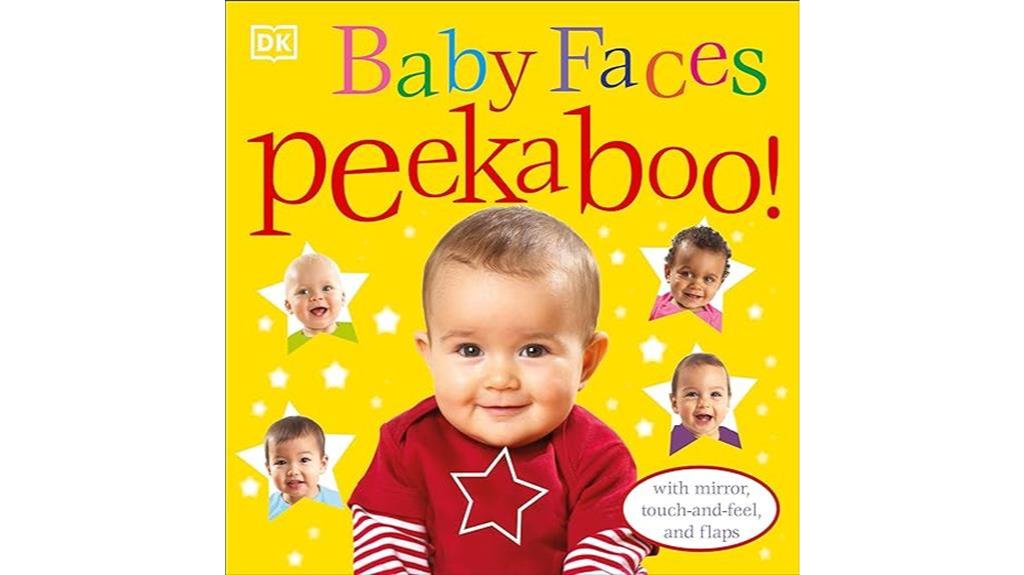
Ideal for babies who are starting to sit up independently, 'Baby Faces Peekaboo!: With Mirror, Touch-and-Feel, and Flaps' offers a stimulating and interactive introduction to emotions through its diverse features. This big and sturdy book is designed for tummy time, featuring a mirror page and showcasing babies of various races expressing different moods.
With a focus on textures, patterns, and empathy, the book engages babies through touch-and-feel elements and interactive flaps. Parents find that the large, sturdy pages make it easy for babies to explore on their own, fostering independence. Children enjoy the different baby faces and emotions depicted, particularly loving the touch-and-feel components and the mirror page.
Highly recommended for babies who can sit up, crawl, and stand, this book continues to captivate children's attention and remains a favorite over time.
Best For: Parents looking for a stimulating and interactive book to introduce emotions to babies during tummy time.
Pros:
- Engages babies through touch-and-feel elements and interactive flaps.
- Features babies of different races expressing various moods, promoting diversity and empathy.
- Large, sturdy pages make it easy for babies to explore independently, fostering motor skills and independence.
Cons:
- Some users initially found the book too big and crowded for younger babies.
- Recommended for babies who can sit up, which may limit its usability for younger infants.
- The size and number of pages in the book may surprise some users.
Babies Love Kindness Lift-a-Flap Board Book
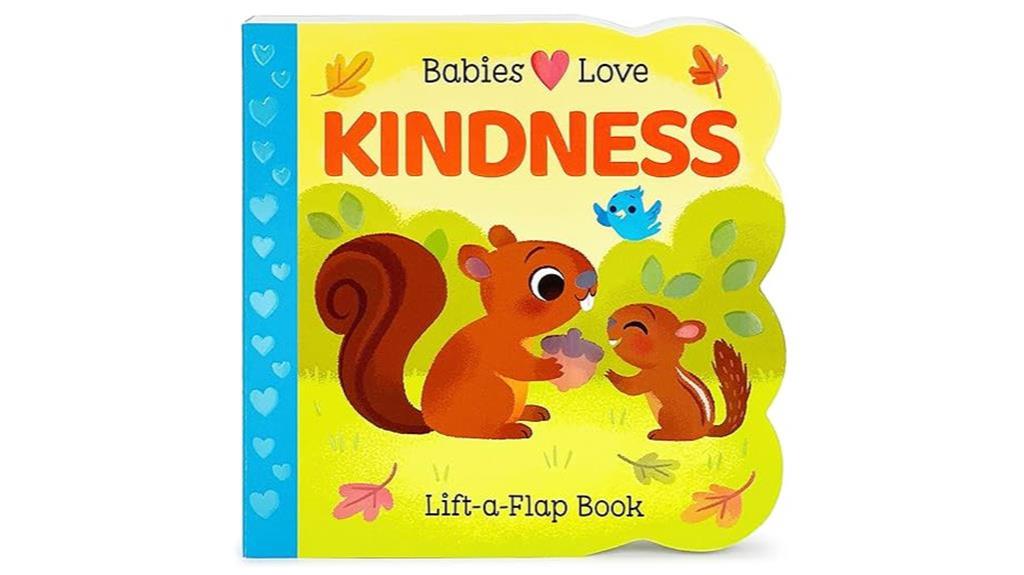
Perfect for introducing babies and toddlers to empathy and kindness, the 'Babies Love Kindness Lift-a-Flap Board Book' offers engaging illustrations and interactive elements to foster social-emotional learning. This board book, part of the Cottage Door Press collection, features colorful and appealing illustrations that attract young children's attention. With 6 sturdy flaps and 12 pages, it encourages interaction, supporting fine motor skill development in little ones.
Parents appreciate the focus on teaching kindness and empathy to children, though some have varying opinions on the phrasing used. The book's durability stands out, with sturdy flaps that can withstand active play. It introduces concepts like helping others and sharing positive words, making it an ideal choice for early learning about emotions and social values.
Designed for babies and toddlers, this book is recommended for its engaging content and durable construction.
Best For: Parents looking to introduce their babies and toddlers to concepts of empathy and kindness through interactive learning.
Pros:
- Engaging illustrations and interactive elements enhance social-emotional learning.
- Durable flaps and sturdy construction make it suitable for active play.
- Introduces important values like helping others and sharing positivity in a fun and educational manner.
Cons:
- Some parents may find the wording in the book less appealing or not as effective in conveying the intended message.
- The thickness of the board book may pose a slight challenge for very young children to handle independently.
- Limited content may not fully cover all aspects of teaching empathy and kindness, depending on individual preferences.
How Does Baby Feel?: A Karen Katz Lift-the-Flap Book
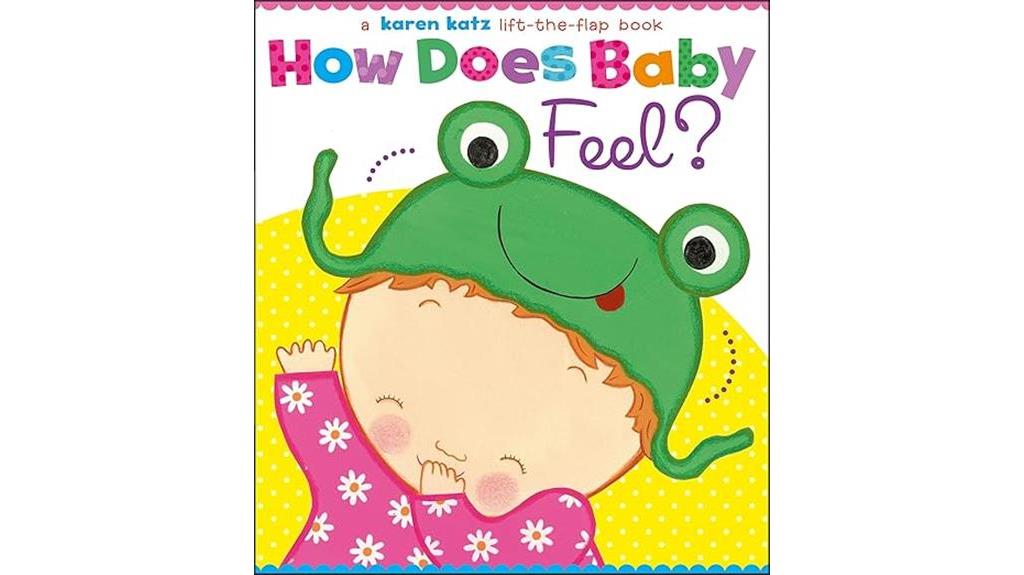
For young children aged 8 months to 2 years old, 'How Does Baby Feel?: A Karen Katz Lift-the-Flap Book' offers an engaging and interactive way to learn about various emotions through sturdy flaps and vibrant illustrations. Parents and children alike appreciate the interactive nature of the book, as children enjoy lifting the flaps to reveal different feelings depicted in the colorful illustrations.
While some users find the flaps slightly challenging for younger children, the book overall aids in language development by introducing feelings words and helping children understand emotions. This book caters to a wide range of ages within the specified group, with parents commending its educational value and ability to entertain young minds.
Additionally, suggestions for including a broader range of emotions like anger have been made, enhancing the book's potential to broaden emotional understanding.
Best For: Parents looking for an interactive and educational book to help their children aged 8 months to 2 years learn about emotions.
Pros:
- Engaging and interactive flaps that children enjoy lifting.
- Sturdy construction that can withstand toddler handling.
- Facilitates language development and emotional understanding through colorful illustrations.
Cons:
- Some users find the flaps challenging for young children to lift.
- Limited range of emotions depicted, with suggestions for including more diverse feelings.
- May not appeal to older children outside the specified age group.
A Little SPOT: My First Emotions (Inspire to Create: A Little Spot)
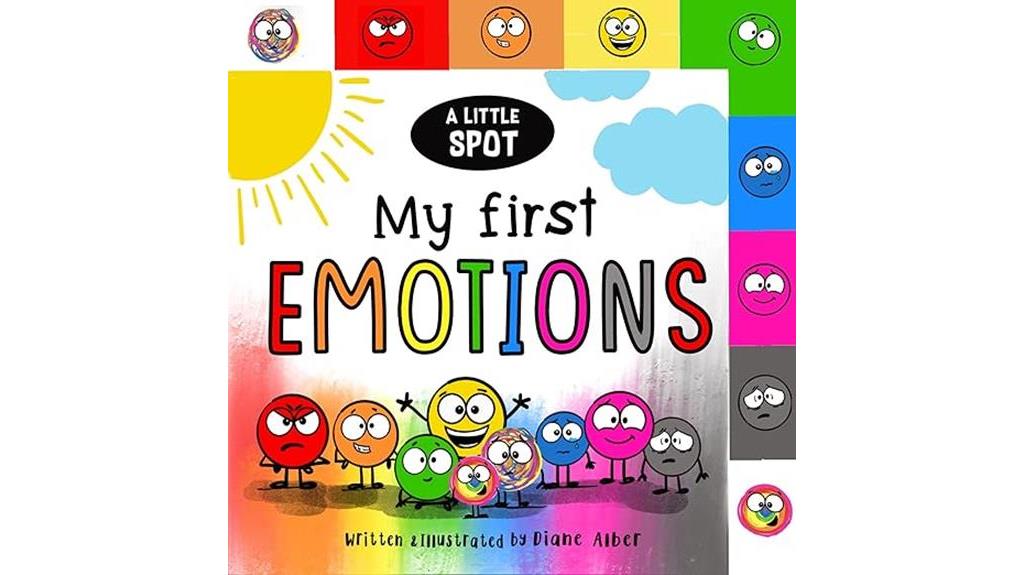
Recommended for children under five, 'A Little SPOT: My First Emotions' helps toddlers understand and express their feelings through colorful associations. This book is well-received by parents, educators, and children, offering a valuable resource for emotional development.
With a focus on helping young ones identify and manage their emotions, the book's educational value lies in its ability to introduce various feelings in an accessible manner. Through engaging illustrations and a layout perfect for toddlers, children find it easy to relate to the emotions portrayed.
To enhance interaction, readers suggest acting out the emotions with children, fostering a deeper understanding. Part of the A Little SPOT series, this book aims to assist children in recognizing and handling emotions in a healthy way, making it a valuable tool for emotional literacy in early childhood.
Best For: Parents looking to help their toddlers understand and manage their emotions through engaging and relatable storytelling.
Pros:
- Engaging illustrations that make it easy for children to relate to the emotions portrayed.
- Helpful resource for emotional development in young children.
- Encourages parents and children to interact by acting out the emotions together for a richer learning experience.
Cons:
- Some customers noted minor physical condition issues with the book.
- Limited to children under five, may not be as beneficial for older children.
- Not suitable for those looking for in-depth emotional development resources for older children.
Shady Baby Feels: A First Book of Emotions
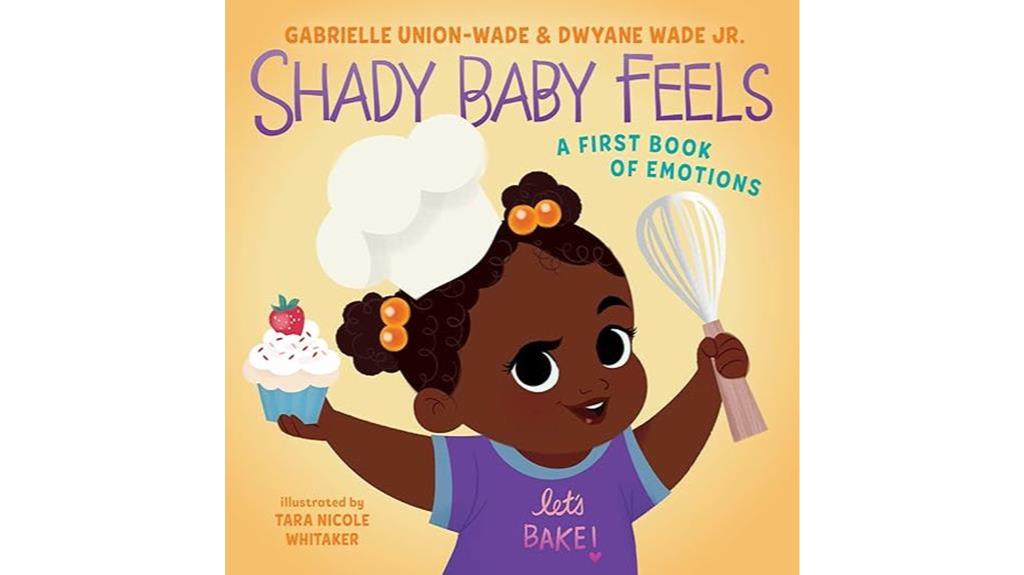
Shady Baby Feels: A First Book of Emotions is an engaging tool for fostering emotional intelligence in young children. Created by Gabrielle Union, Dwyane Wade, and Tara Nicole Whitaker, this book features Shady Baby baking cupcakes while expressing nine common emotions.
The vibrant and eye-catching illustrations make it a hit with kids, encouraging them to explore and understand their feelings in a fun and relatable way. Perfect for tiny hands with its sturdy pages, Shady Baby Feels is designed to introduce emotional literacy, self-awareness, and empathy to toddlers.
Despite some reports of minor damage upon delivery and mixed reviews on the writing style, the book is praised for its representation of diverse characters and its positive impact on early childhood mental health. Recommended for those seeking an affordable read that helps young children navigate their emotions.
Best For: Parents seeking an engaging tool to introduce emotional intelligence and empathy to young children.
Pros:
- Features vibrant and eye-catching illustrations that engage children.
- Introduces nine common emotions in a kid-friendly format.
- Promotes discussions about feelings and emotions in a relatable way.
Cons:
- Some customers reported receiving damaged copies.
- Mixed reviews on the writing style.
- Limited in-depth storytelling due to its focus on emotions.
How Do I Feel?: A little guide to my emotions (First Emotions)
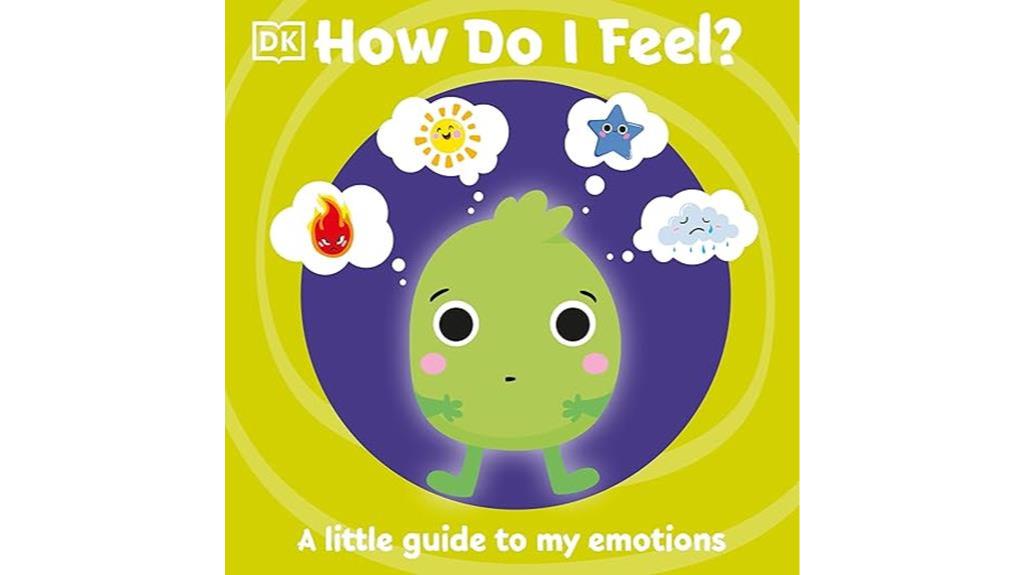
Exploring the colorful illustrations and engaging stories in 'How Do I Feel?: A little guide to my emotions (First Emotions)' is a delightful way for young children to begin understanding and expressing their feelings. This book serves as a quality introduction to emotions for preschoolers, focusing on four key emotions through easy-to-read text and engaging illustrations tailored for young minds.
By teaching children to recognize and name different emotions, it helps them understand how feelings can lead to various actions and the physical and emotional effects they may experience. Moreover, 'How Do I Feel?' encourages children to express and discuss their emotions, promoting vocabulary building and emotional development.
This book not only aids in identifying and discussing emotions but also provides a platform for children to start comprehending the complexities of their feelings.
Best For: Parents and educators looking for a simple and engaging way to introduce young children to basic emotions and encourage emotional development.
Pros:
- Quality introduction to emotions for preschoolers.
- Easy-to-read text and engaging illustrations.
- Encourages children to recognize, name, and discuss their emotions.
Cons:
- Lacks depth in explaining feelings.
- Some wording may be confusing for young children.
- May need modification for age-appropriateness.
Baby Emotions: My First Book of Emotions For Babies
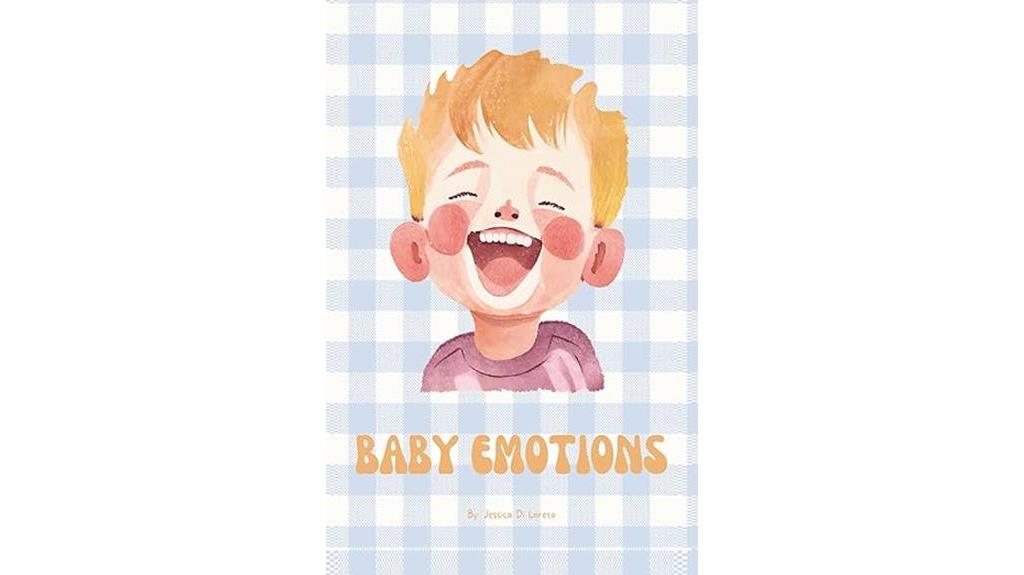
The 'Baby Emotions: My First Book of Emotions For Babies' is a valuable resource for parents seeking to introduce their infants and toddlers to a range of emotions through engaging visuals and relatable facial imagery. This charming baby book is designed to help children explore their first emotions in a fun and interactive way.
With enchanting illustrations and simple, relatable facial expressions, the book covers a spectrum of feelings from joy to sadness, surprise, and more. By providing a gentle introduction to emotional awareness, Baby Emotions aims to foster emotional intelligence from an early age.
The thoughtfully crafted design and delightful illustrations make it an engaging tool for children to learn about their emotions, while also serving as a valuable resource for parents and caregivers looking to support their little ones' emotional development.
Best For: Parents and caregivers looking to introduce their infants and toddlers to a range of emotions in a fun and interactive way.
Pros:
- Engaging visuals and relatable facial imagery
- Covers a spectrum of feelings from joy to sadness and surprise
- Fosters emotional intelligence from an early age
Cons:
- May require parental guidance for effective learning
- Limited to basic emotions, may not cover more complex feelings
- Relies heavily on visual stimuli, may not suit all learning styles
Factors to Consider When Choosing a Baby Emotions Book

When selecting a baby emotions book, it's important to take into account key selection criteria like the book's relevance to your child's age and developmental stage. Assessing interactive features and the emotional range coverage can help guarantee a well-rounded experience for your little one.
Moreover, the significance of engaging visuals can't be overstressed, as they play a vital role in capturing a child's attention and enhancing their learning process.
Key Selection Criteria
Considering the age appropriateness of a baby emotions book is vital when selecting the right one for your child. Ensuring that the content aligns with your child's developmental stage is critical for effective learning.
Look for books that offer diverse representations of emotions to foster inclusivity and a broader understanding of feelings. Interactive elements like flaps, mirrors, or textured pages can enhance your child's engagement through a multisensory learning experience.
Opt for books with clear, simple language and vibrant illustrations to captivate your child's attention and facilitate understanding. It's beneficial to choose books that cover a wide range of emotions beyond just the basics. This approach encourages a more thorough understanding of feelings and helps your child develop emotional intelligence.
Age-Appropriate Content
To choose a suitable baby emotions book, focus on the content that aligns with your child's age and introduces basic emotions in a relatable manner. Select a book that covers emotions like happy, sad, surprised, and more in a straightforward and captivating way tailored to young children's understanding.
It's crucial to make sure that the content matches your child's developmental stage to capture their interest effectively. Seek out books with clear and expressive visuals that make it simple for children to recognize and identify different feelings.
Opting for books with interactive elements or activities can also enhance your child's learning experience by encouraging them to explore and engage with the emotions being presented. By choosing a baby emotions book with age-appropriate content, you can provide your little one with a valuable tool for understanding and managing their own feelings.
Interactive Features Evaluation
I always prioritize selecting baby emotions books that feature interactive elements, such as flaps, mirrors, or touch-and-feel components, to engage children in a hands-on learning experience about different feelings.
Interactive features play a pivotal role in capturing a child's attention and encouraging active participation in understanding emotions.
When choosing a baby emotions book, it's essential to ponder if the book includes activities that prompt children to mimic facial expressions or engage in tasks related to identifying and expressing emotions.
The level of interactivity in the book should be evaluated, looking for prompts that encourage children to match emotions, make faces in a mirror, or lift flaps to reveal different expressions.
These interactive features not only make learning about feelings enjoyable and memorable for young children but also contribute to their emotional development by providing tangible experiences that enhance their comprehension of various emotions.
Emotional Range Coverage
Exploring the emotional range covered by a baby emotions book is important when selecting the right one for young children. It's necessary to consider whether the book encompasses a wide variety of emotions, ranging from basic ones like happiness and sadness to more intricate feelings such as surprise and fear.
Look for books that introduce emotions clearly and in a relatable manner for babies and toddlers to grasp and connect with effectively. Ensure that the book addresses key emotions important for early emotional development, including joy, anger, fear, and love.
Check if the book aids children in identifying and expressing a diverse range of emotions through engaging visuals and simple descriptions. Opt for books that offer a thorough overview of different emotions, enabling children to learn about and process their feelings efficiently.
Engaging Visuals Importance
Engaging visuals play an integral role in selecting a baby emotions book. They are important for capturing a baby's attention and facilitating their emotional learning journey. Bright colors, expressive facial images, and simple designs are key elements that can help babies recognize and connect with different emotions effectively.
Visual cues are significant in aiding babies to understand and respond to the various feelings they encounter during their developmental stages. Incorporating interactive elements such as flaps, mirrors, and touch-and-feel textures can further enhance the visual experience, promoting engagement and sensory exploration.
It's vital to choose age-appropriate visuals that are clear, bold, and relatable to make sure that babies can grasp the concept of emotions proficiently. By selecting books with engaging visuals that align with a baby's cognitive development, caregivers can actively support their little ones in navigating the intricate world of emotions.
Parental Guidance Role
When selecting a baby emotions book, parents should consider various factors that can enhance their child's emotional learning journey. Parents play a vital role in guiding their children through understanding feelings by providing support, empathy, and modeling positive expression of emotions. By engaging in open conversations about emotions, validating their child's feelings, and teaching healthy coping strategies, parents can help children manage and express their emotions effectively.
Creating a safe and nurturing environment at home is essential for children to explore and comprehend a wide range of emotions. Utilizing books, activities, and everyday experiences can aid parents in helping children identify, label, and regulate their emotions. Hence, parents should choose baby emotions books that align with their parenting style and values, offering content that facilitates discussions about feelings and provides tools for emotional development.
Educational Value Assessment
I consider various factors when choosing a baby feelings book for my child to ensure it promotes emotional learning effectively. One important aspect is evaluating the book's ability to introduce and teach basic emotions like joy, sorrow, and astonishment to babies and toddlers. It's vital to assess how the book encourages interactive learning by prompting children to imitate facial expressions and recognize emotions, fostering engagement and understanding.
Age appropriateness is another significant factor, guaranteeing that the content is suitable for children aged 1 to 5 years old to understand and engage with effectively. Additionally, examining how the book aids in cultivating emotional intelligence in young children by assisting them in identifying and expressing their feelings is crucial.
Besides, considering how the book's content and design contribute to a child's emotional learning journey, providing a foundation for understanding and managing emotions, is necessary for a thorough emotional development. By taking into account these factors, I can choose a baby feelings book that offers valuable educational benefits for my child's emotional growth.
Frequently Asked Questions
How Can I Help My Baby Express Their Emotions Effectively?
I help my baby express emotions by acknowledging their feelings, providing a safe environment for expression, and using simple language to label emotions. I offer comfort and support, encouraging healthy emotional development.
Are These Books Suitable for Babies With Sensory Sensitivities?
Around 20% of babies have sensory sensitivities. While these books may be helpful for some, it's important to take into account individual needs. I suggest consulting a pediatrician or child development specialist for tailored recommendations.
Can Reading These Books Help Babies Develop Empathy?
Reading these books can nurture empathy in babies by exposing them to various emotions. Through colorful illustrations and simple stories, babies can begin to understand and recognize feelings, fostering a sense of compassion and understanding.
Do These Books Include Interactive Elements for Sensory Exploration?
They engage babies with textured pages, peek-a-boo flaps, and sound buttons for sensory exploration. The interactive elements enhance their learning experience and make understanding feelings more fun and engaging.
Are There Any Tips for Parents on Using These Books to Teach Emotions Effectively?
I find that using these books as conversation starters is key. Ask open-ended questions, relate stories to real-life experiences, and mirror emotions with facial expressions. Encourage empathy and validate feelings to enhance emotional learning.
Conclusion
To sum up, exploring baby emotions through books can help little ones understand and navigate their feelings as they grow.
Remember, 'A picture is worth a thousand words,' and these baby emotions books are filled with vibrant illustrations and simple language to engage young minds.
By introducing these books early on, parents can assist in building emotional intelligence and communication skills in their children, setting a strong foundation for healthy emotional development.

